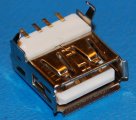To me its not about the wording of the definiton.
Sometimes I think too much emphasis is put into the "Wording" of things.
I just think there should be a better dividing line between Line Voltage outlets and Low Voltage outlets.
To me, putting the USB Outlets and 120v Receptacle outlets in the same category doesnt seem right just because of the wording but that's JMHO.
JAP>
What JAP said!
Is a device which contains a 120 volt receptacle and Type F coax cable jack a duplex receptacle? There there is no active device associated with the cable jack but there is a communications wiring system behind it.
I would call this "complicated" and a combination of features and equipment which was not contemplated at the time the definition was written. Therefore the definition does not apply well.
1. If this were a wall wart to serve the same purpose, it would, I think, be agreed that the wall wart is utilization equipment whose purpose is to supply power to other utilization equipment and that output power is not carried through a wiring system, or at least not one which is part of the building. In the case of a power brick, the separation is even clearer. The wiring from the brick to the computer, etc. is covered by UL, but is not directly addressed by the NEC.
2. In this case, we have moved the wall wart into the device itself and contained it entirely within the wall box. That blurs the distinction between utilization equipment and the associated receptacles/outlets.
3. The "USB ports" in this device are not actually USB ports in that there is no data interconnection to other devices, indeed no data wire connections at all. This is simply a power supply which uses the power provisions of the USB specification to deliver its output. There should be an official designation for a power-only USB receptacle.
4. The original convention for use of USB connector Series A and B was that a Series A connector was used on a USB master port, such as a computer, and the Series B connector was used on a peripheral device to be attached via USB to that computer. Now we have, in addition to using Series A at both ends, mini-USB (trapezoid) and micro-USB (oval) connectors as well as the mechanically incompatible USB 3.0 connector for high speed wiring, which still supports USB 1 and 2 communications as well!






